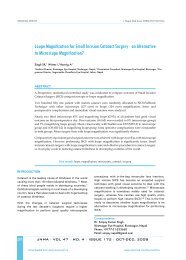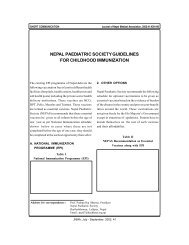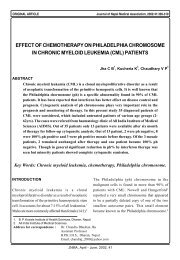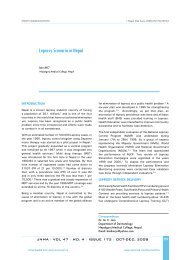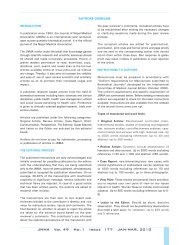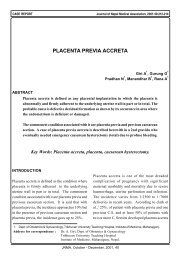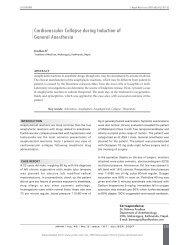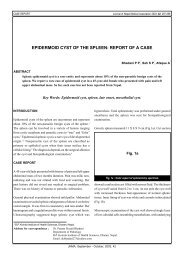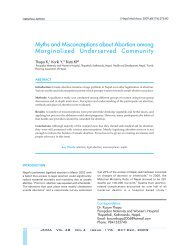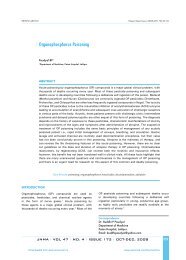Proximal Femoral Nail in Intertrochanteric Femoral Fractures
Proximal Femoral Nail in Intertrochanteric Femoral Fractures
Proximal Femoral Nail in Intertrochanteric Femoral Fractures
Create successful ePaper yourself
Turn your PDF publications into a flip-book with our unique Google optimized e-Paper software.
Mehboob et al. <strong>Proximal</strong> <strong>Femoral</strong> <strong>Nail</strong> <strong>in</strong> <strong>Intertrochanteric</strong> <strong>Femoral</strong> <strong>Fractures</strong><br />
METHODS<br />
This is a retrospective, multicentered study done at two<br />
<strong>in</strong>stitutions, Postgraduate Medical Institute, Lahore and<br />
S<strong>in</strong>dh Government Lyari General Hospital, Karachi from<br />
February, 2005 – February, 2007 for unstable fractures<br />
of proximal femur us<strong>in</strong>g the PFN. Hospital record files<br />
were used to chose the patients who were called back<br />
for review if needed. Ethical approval was taken from<br />
the ethical committee of the hospital and data was<br />
analyzed us<strong>in</strong>g the SPSS version 14. Serial X-rays if<br />
available were used to assess progress of union<br />
postoperatively. Only cases, where X-rays, at least 1<br />
year after surgery were available for review or the patient<br />
who could come back for review were <strong>in</strong>cluded (Figure<br />
1).<br />
Figure 1. Radiographs of two cases taken six weeks<br />
after surgery.<br />
Operative technique<br />
All were operated under C-arm. The patients were put<br />
<strong>in</strong> sup<strong>in</strong>e position with the affected side up. A small<br />
<strong>in</strong>cision over the greater trochanter area was made and<br />
the tip of greater trochanter was exposed and entry po<strong>in</strong>t<br />
made by us<strong>in</strong>g the femoral awl. Us<strong>in</strong>g the guide wire<br />
and the cannulated reamers the proximal femur was<br />
reamed. Hav<strong>in</strong>g seated the nail <strong>in</strong> the proximal femur the<br />
compression screw was <strong>in</strong>troduced. The distal <strong>in</strong>terlock<strong>in</strong>g<br />
screws were placed through the jig provided with the<br />
<strong>in</strong>strumentation. The f<strong>in</strong>al position was checked under<br />
the image <strong>in</strong>tensifier. The patients were given <strong>in</strong>tra venous<br />
antibiotics as prophylaxis. All were encouraged to start<br />
non weight bear<strong>in</strong>g crutch mobilization after 24 hours<br />
of surgery. Low molecular weight hepar<strong>in</strong> was used to<br />
prevent deep ve<strong>in</strong> thrombosis. All were discharged on<br />
second post operative day except when needed for other<br />
compell<strong>in</strong>g reasons.<br />
In out patient serial X-rays were taken at monthly <strong>in</strong>tervals<br />
and gradual weight bear<strong>in</strong>g was started around 6 weeks<br />
after surgery.<br />
RESULTS<br />
In all 32 patients, record was available for review but<br />
only 26 were on follow up. All patients who had been<br />
operated had returned to their work or pre-<strong>in</strong>jury status.<br />
There was radiological union accompanied by appropriate<br />
cl<strong>in</strong>ical f<strong>in</strong>d<strong>in</strong>gs. The average age of the study population<br />
was 57.24 years (range: 35-70 years). Total 10/26 were<br />
<strong>in</strong>jured <strong>in</strong> a road traffic accident and rest had domestic<br />
fall. One patient developed superficial wound <strong>in</strong>fection<br />
which settled with <strong>in</strong>tra venous antibiotics selected as<br />
per culture studies. Three patients had displacement of<br />
antirotation screws dur<strong>in</strong>g follow up at some stage<br />
(11.53%). One patient compla<strong>in</strong>ed of pa<strong>in</strong> over the<br />
trochanter area dur<strong>in</strong>g follow up. There was one case of<br />
deformation of trochanteric screw after weight bear<strong>in</strong>g.<br />
All were ambulant at the time of f<strong>in</strong>al compilation of<br />
results (Table 1).<br />
DISCUSSION<br />
The f<strong>in</strong>d<strong>in</strong>gs of Miedel <strong>in</strong>dicate that the Gamma <strong>Nail</strong><br />
showed good results <strong>in</strong> both trochanteric and<br />
subtrochanteric fractures. 6 Incidence of technical failure<br />
<strong>in</strong> patients with unstable trochanteric fracture was 6.5%<br />
(6/93) <strong>in</strong> the Standard Gamma <strong>Nail</strong> group and 5.2%<br />
(5/96) <strong>in</strong> the Medoff Slid<strong>in</strong>g Plate group. 6 Patients treated<br />
with an <strong>in</strong>tramedullary nail have had shorter operative<br />
time, fewer blood transfusions, and shorter hospital stay<br />
compared with those treated with a 95° DHS. 1 Our<br />
operation time is far less than quoted by other studies.<br />
In the study by Menezes, out of 129 patients available<br />
for follow-up failure of fixation occurred <strong>in</strong> three patients<br />
(2%), and a femoral shaft fracture occurred <strong>in</strong> one patient<br />
(0.7%). 4 No such event has been noted by us as yet<br />
but our follow up is very short, as time passes by we<br />
may note other problems. Fixation failures <strong>in</strong>cluded one<br />
cutout, one delayed fracture heal<strong>in</strong>g, and one lateral<br />
displacement of the antirotation screw. In other studies<br />
total re-operation rate was high (12%) ma<strong>in</strong>ly because<br />
of hardware removals, which occurred <strong>in</strong> 13 patients<br />
(8.6%). Stratification of results showed that hematomas<br />
and iliotibial tract irritation occurred more commonly with<br />
lesser surgical experience. 4 We have a very small group<br />
of patients hence cannot comment on problems related<br />
to learn<strong>in</strong>g curve of the procedure but we have noted<br />
our operat<strong>in</strong>g time decreased with <strong>in</strong>crease <strong>in</strong> experience.<br />
Generally, the results of treatment of unstable trochanteric<br />
fractures were comparable for the PFN and Gamma <strong>Nail</strong>.<br />
The pitfalls and complications were similar, and ma<strong>in</strong>ly<br />
surgeon or fracture-related, rather than implant-related. 2<br />
Our operat<strong>in</strong>g time was short and we did not have to<br />
transfuse blood post operatively. In other studies the<br />
<strong>in</strong>tra-operative blood loss was lower with the PFN (220<br />
ml v 287 ml, p = 0.001). 2 We did not make any direct<br />
measurements of blood lost dur<strong>in</strong>g surgery and accept<br />
this as a limitation of our f<strong>in</strong>d<strong>in</strong>gs. Post-operatively,<br />
more lateral protrusion of the hip screws of the PFN<br />
(7.6%) was documented, compared with the gamma nail<br />
(1.6%, p = 0.02) <strong>in</strong> the series published by Schipper. 2<br />
274<br />
JNMA I Vol 48 I No. 4 I Issue I176 I Oct-Dec, 2009



